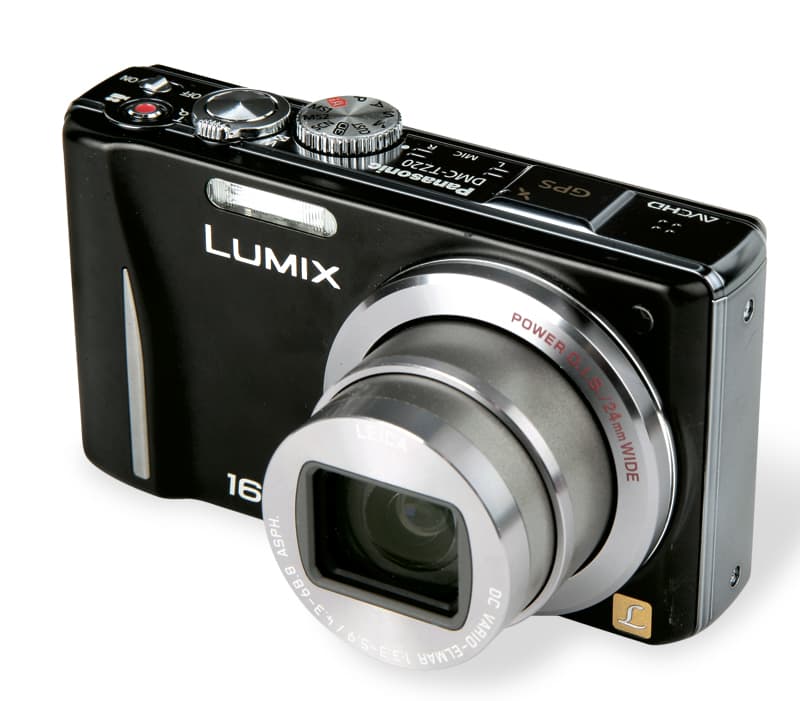Panasonic Lumix DMC-TZ20 at a glance:
- 14.1 million effective pixels
- 24-384mm, 16x optical zoom
- 1080i HD video
- 3in, 460,000-dot touchscreen
- GPS
- 60fps burst mode
- Street price around £349
Panasonic Lumix DMC-TZ20 review – Introduction
Panasonic’s previous flagship TZ model, the Lumix DMC-TZ10, was AP’s Consumer Compact Camera of the Year 2011. It was not just the impressive 12x optical zoom lens that won it the accolade, but a host of great features, too. The Panasonic Lumix DMC-TZ20 replaces this model, and a glance at the specification suggests it offers significant changes to most of the key features.
Of the more notable refinements to the Panasonic Lumix DMC-TZ20 it is the Leica DC Vario-Elmar lens with 16x optical zoom that is likely to stir the most interest. It has been expanded at both the wide and telephoto ends, and offers a staggering 24-384mm focal range.
Furthermore, with its super-fast frame rates, built-in GPS and both auto and manual exposure controls, this could well be the lightweight and versatile camera to keep in your pocket.
Features
 While the improved optical zoom may take centre stage, there have been many changes inside the TZ20. In fact, it has undergone something of an overhaul.
While the improved optical zoom may take centre stage, there have been many changes inside the TZ20. In fact, it has undergone something of an overhaul.
Rather than the CCD sensor used in the TZ10, the TZ20 has a CMOS sensor with 15.1 million pixels, of which up to 14.1 million are used for each image. This marks a two-million-effective-pixel increase, packed into the same 1/2.3in-size sensor.
As with the TZ10, different parts of the sensor are used depending on the aspect ratio, so the number of pixels employed relates directly to the aspect ration in use, be it 1:1, 3:2, 4:3 or 16:9.
Another key feature is the 3in, 460,000-dot screen, which now provides touch functionality. This adds another method of zoom, autofocus and shutter release control, as well as an intuitive way to view photos in playback mode.
The term ‘3D’ is one that we will become very familiar with this year, and this is especially the case with Panasonic cameras. A 3D shooting mode has been introduced on the TZ20 and a 3D image is achieved by holding down the shutter release and moving the camera from left to right as it takes several exposures.
 This image is taken from a 14-exposure sequence achieved using the 40fps burst mode. In this mode images are at a reduced 5MP in size
This image is taken from a 14-exposure sequence achieved using the 40fps burst mode. In this mode images are at a reduced 5MP in size
There is a variety of frame rates available with differing levels of picture size and AF control during shooting, and they can be found easily in the quick menu. Up to 5fps is possible with continuous AF, and up to 10fps at full resolution. Burst modes of 40 and 60fps are an impressive feature for any camera system, although they come at a reduced image size. The new slow-motion video mode takes the number of scene modes to 30. In standard HD video mode, the TZ20 now offers 1080i recording, which is likely to please video users.
Other useful features inherited from the previous model include GPS, intelligent auto and PASM control. The TZ20 is a feature heavyweight and is likely to entertain both the novice and enthusiast photographer.
Build and Handling
Those familiar with the TZ10 will be hard-pressed to distinguish changes to the exterior of the TZ20. General build quality is good, if not fairly standard for a small compact camera at this price.
Apart from the more contoured handgrip, it is virtually the same compact size with a depth of 33mm, which is impressive given the increase in optical zoom.
Interestingly, despite using a touchscreen, the button layout is largely unchanged but for the movie record button being moved to the top of the body and the new 3D mode included on the shooting dial.
A CMOS sensor is cheaper to manufacture than a CCD sensor, and this is perhaps why the company is able to offer other features, such as the new touchscreen, without an increase in price from last time round.
Touch-focusing is achieved by touching the part of the frame the user wants to be in focus. The screen adjusts its power automatically by detecting the brightness of the location, which means it will be brighter in direct sunlight but dimmer in evening light.
I find a compromise with touchscreens is that they have a tendency to be slightly less bright than similarly specified LCD screens, and the TZ20 is true to form.
Offering manual and autoexposure controls as well as several scene modes means that photographers of any skill level should feel at home using the TZ20. Its exposure control is not without its limits, however, as the aperture range is rather restricted.
At its widest focal length, the TZ20 offers a range of f/3.3-6.3, while at its telephoto end f/5.9 or f/6.3 is available. Autobracketing and exposure compensation is easily achieved and available up to ±1 and ±2 respectively in 1⁄3EV steps.
Exposure in any of the PASM modes is adjusted using the exposure button on the back of the camera.
The quick menu displays white balance, ISO, image size and record quality, GPS and burst modes. The 30 scene modes are accessed via the main menu. This is a camera that gives simple access to shooting modes, exposure and focusing controls, and is easy to navigate for a variety of skill levels.
Performance
Compact cameras often produce overly saturated colours, even in their standard shooting mode. Fortunately, this is not the case with the TZ20.
Images show a natural tone and, for those who like vivid results, there is the appropriate scene mode to provide this. Auto white balance gives sufficient results in most situations and manual white balance is available when the results are not quite up to scratch.
Viewing images at 100% shows detail to be rather smudged and watercolour-like. As a result, images feel a little soft and lacking punch. This is not unusual for a compact camera, however, and image quality is on a par with similar models. What the competition does not offer, though, is a 24-384mm lens.
Image quality is consistent throughout the range, and zooming to and from each extreme takes just under three seconds. Pictures taken at more telephoto focal lengths are helped no end by the built-in optical image stabiliser. With a steady hand it is feasible to shoot at around 1/15sec without visible signs of camera shake.
Fifteen million pixels is an impressive resolution and a maximum file size of around 6MB comfortably produces A3 prints without interpolation. The pixels are packed into a compact 1/2.3in sensor so the size of the photosites is reduced, which takes its toll on the camera’s dynamic range and noise levels.
Exposures lack the dynamic range of a DSLR, for example, and there is a clear tendency to expose for the midtones and shadows. Highlights, such as an overcast sky, more often than not appear as a solid area of bright white.
This was still the case when manually tweaking the exposure by -0.6EV, which was the setting I generally opted for before midtones became too dark. The TX20 fares better in brighter sunlight. Once again, none of this is unusual for a compact camera.
Noise is well controlled at ISO 100 and 200, and the first real visible signs of luminance noise come in around ISO 400.
 In overcast conditions, exposures are bright but sky detail often appears as a block of white
In overcast conditions, exposures are bright but sky detail often appears as a block of white
It is particularly evident at ISO 800 and 1600, but there is still a respectable level of resolution detail at these settings.
What comes with a greater focal range is a new structure of the lens. This is a contributing factor to the slightly slower lens when directly compared to the lens of the TZ10. At 300mm the TZ10 has a minimum aperture of f/4.9, but at the same focal length on the TZ20 it is f/5.7, or f/5.9 at 384mm.
A major benefit of a CMOS sensor is that it traditionally consumes much less power than a CCD sensor. This helps compensate for some of the power-hungry new features.
However, according to Panasonic’s website, the 300 shots possible on a full charge when using the TZ10 has been reduced to 260 shots with the TZ20. This is still fairly standard for a camera at this level, but it should be noted that the GPS function drains the battery somewhat.
Autofocus is as responsive as one would expect from a camera of this type. In bright conditions there are no focusing issues, but the TZ20 struggles a bit in poor-contrast light. Continuous AF in the 5fps mode is a great asset. The fast frame rates are good fun to shoot with and I am pleased with the handling.
In each mode just over one second of shooting is available before the rate either slows down or the burst stops. Information is processed surprisingly quickly, and a 60fps burst is viewable in around four seconds.

Resolution images: These images show 72ppi (100% on a computer screen) sections of images of a resolution chart, captured with the lens set to its 100mm point. We show the section of the resolution chart where the camera starts to fail to reproduce the lines separately. The higher the number visible in these images, the better the camera’s detail resolution is at the specified sensitivity setting.
Our verdict
The TZ20 certainly has an impressive array of features, and they should entertain the enthusiast and novice photographer equally. The same can be said for its ease of use and quick handling in each of the numerous shooting modes – I had great fun experimenting with them. I was also pleased with how easily I could set the exposure manually.
In terms of image quality, the TZ20 is on a par with many like-for-like models, but it has the bonus of greater flexibility with its class-leading zoom range. Whether you like having a versatile camera for your travels or one in your pocket at all times, the TZ20 further establishes the Panasonic TZ series as a great option.







